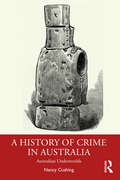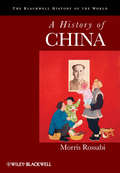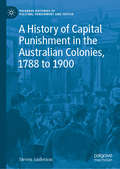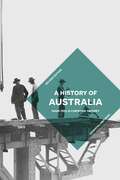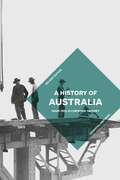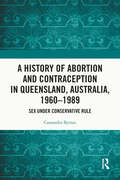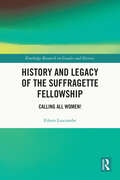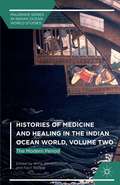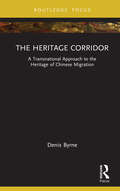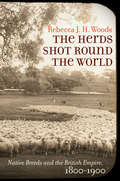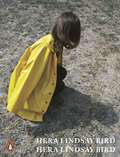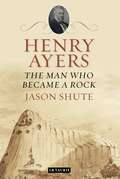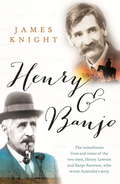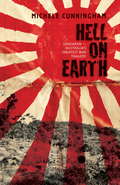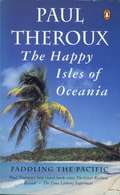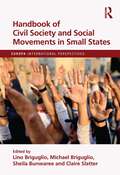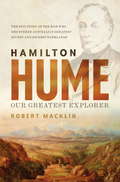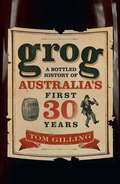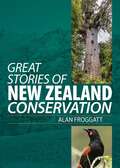- Table View
- List View
A History of Crime in Australia: Australian Underworlds
by Nancy CushingThis book provides a lively and accessible account of Australia’s most prominent crimes and criminals of the nineteenth and twentieth century and offers an informative background for those seeking to understand crimes committed today. A History of Crime in Australia examines the imposition of English law on this ancient continent, and how its operation affected both transported offenders from Great Britain and Ireland, and the Aboriginal and Torres Strait Islander peoples whose own systems of Law were overlaid. Drawing upon cutting-edge research in the field, original work by the author, and essays from leading crime history researchers, it addresses the question of whether there was an Australian underworld. In doing so, it provides background for well known offenders including bushranger Ned Kelly and the razor gangs of the 1920s and for sensational crimes like the Mount Rennie Outrage, the Pyjama Girl Mystery and the Shark Arm Murder and the miscarriage of justice following the disappearance of Azaria Chamberlain at Uluru in 1980. Through these case studies, the book draws out points of tension and cohesion within Australian society, exposing the enduring anxiety around those who were considered to be outsiders, and how the criminal justice system was used to manage these concerns. This book includes a guide to conducting research in the field of Australian crime history and sources for further study. Designed as an introductory text for students, this book will be of interest to those studying criminology and crime history, and anyone who would like to deepen their understanding of crime’s place in Australia’s social and cultural history.
A History of Crime in Australia: Australian Underworlds
by Nancy CushingThis book provides a lively and accessible account of Australia’s most prominent crimes and criminals of the nineteenth and twentieth century and offers an informative background for those seeking to understand crimes committed today. A History of Crime in Australia examines the imposition of English law on this ancient continent, and how its operation affected both transported offenders from Great Britain and Ireland, and the Aboriginal and Torres Strait Islander peoples whose own systems of Law were overlaid. Drawing upon cutting-edge research in the field, original work by the author, and essays from leading crime history researchers, it addresses the question of whether there was an Australian underworld. In doing so, it provides background for well known offenders including bushranger Ned Kelly and the razor gangs of the 1920s and for sensational crimes like the Mount Rennie Outrage, the Pyjama Girl Mystery and the Shark Arm Murder and the miscarriage of justice following the disappearance of Azaria Chamberlain at Uluru in 1980. Through these case studies, the book draws out points of tension and cohesion within Australian society, exposing the enduring anxiety around those who were considered to be outsiders, and how the criminal justice system was used to manage these concerns. This book includes a guide to conducting research in the field of Australian crime history and sources for further study. Designed as an introductory text for students, this book will be of interest to those studying criminology and crime history, and anyone who would like to deepen their understanding of crime’s place in Australia’s social and cultural history.
A History of China (Blackwell History of the World)
by Morris RossabiCapturing China’s past in all its complexity, this multi-faceted history portrays China in the context of a larger global world, while incorporating the narratives of Chinese as well as non-Chinese ethnic groups and discussing people traditionally left out of the story—peasants, women, merchants, and artisans. Offers a complete political, economic, social, and cultural history of China, covering the major events and trends Written in a clear and uncomplicated style by a distinguished historian with over four decades of experience teaching undergraduates Examines Chinese history through the lens of global history to better understand how foreign influences affected domestic policies and practices Depicts the role of non-Chinese ethnic groups in China, such as Tibetans and Uyghurs, and analyzes the Mongol and Manchu rulers and their impact on Chinese society Incorporates the narratives of people traditionally left out of Chinese history, including women, peasants, merchants, and artisans
A History of China (Blackwell History of the World)
by Morris RossabiCapturing China’s past in all its complexity, this multi-faceted history portrays China in the context of a larger global world, while incorporating the narratives of Chinese as well as non-Chinese ethnic groups and discussing people traditionally left out of the story—peasants, women, merchants, and artisans. Offers a complete political, economic, social, and cultural history of China, covering the major events and trends Written in a clear and uncomplicated style by a distinguished historian with over four decades of experience teaching undergraduates Examines Chinese history through the lens of global history to better understand how foreign influences affected domestic policies and practices Depicts the role of non-Chinese ethnic groups in China, such as Tibetans and Uyghurs, and analyzes the Mongol and Manchu rulers and their impact on Chinese society Incorporates the narratives of people traditionally left out of Chinese history, including women, peasants, merchants, and artisans
A History of Capital Punishment in the Australian Colonies, 1788 to 1900 (Palgrave Histories of Policing, Punishment and Justice)
by Steven AndersonThis book provides a comprehensive overview of capital punishment in the Australian colonies for the very first time. The author illuminates all aspects of the penalty, from shortcomings in execution technique, to the behaviour of the dying criminal, and the antics of the scaffold crowd. Mercy rates, execution numbers, and capital crimes are explored alongside the transition from public to private executions and the push to abolish the death penalty completely. Notions of culture and communication freely pollinate within a conceptual framework of penal change that explains the many transformations the death penalty underwent. A vast array of sources are assembled into one compelling argument that shows how the ‘lesson’ of the gallows was to be safeguarded, refined, and improved at all costs. This concise and engaging work will be a lasting resource for students, scholars, and general readers who want an in-depth understanding of a long feared punishment.Dr. Steven Anderson is a Visiting Research Fellow in the History Department at The University of Adelaide, Australia. His academic research explores the role of capital punishment in the Australian colonies by situating developments in these jurisdictions within global contexts and conceptual debates.
A History of Australia (Macmillan Essential Histories)
by Mark Peel Christina TwomeyThis vivid, multi-dimensional history considers the key cultural, social, political and economic events of Australia’s history. Deftly weaving these issues into the wider global context, Mark Peel and Christina Twomey provide an engaging overview of the country’s past, from its first Indigenous people, to the great migrations of recent centuries, and to those living within the more anxiously controlled borders of the present day. This engaging textbook is an ideal resource for undergraduate students and postgraduate students taking modules or courses on the History of Australia. It will also appeal to general readers who are interested in obtaining a thorough overview of the entire history of Australia, from the earliest times to the present, in one concise volume.
A History of Australia (Macmillan Essential Histories)
by Mark Peel Christina TwomeyThis vivid, multi-dimensional history considers the key cultural, social, political and economic events of Australia's history. Deftly weaving these issues into the wider global context, Mark Peel and Christina Twomey provide an engaging overview of the country's past, from its first Indigenous people, to the great migrations of recent centuries, and to those living within the more anxiously controlled borders of the present day.This engaging textbook is an ideal resource for undergraduate students and postgraduate students taking modules or courses on the History of Australia. It will also appeal to general readers who are interested in obtaining a thorough overview of the entire history of Australia, from the earliest times to the present, in one concise volume.
A History of Abortion and Contraception in Queensland, Australia, 1960–1989: Sex under Conservative Rule
by Cassandra ByrnesThis book looks at the recent history of sex, contraception, and abortion in Australia’s most conservative state, Queensland. In western nations, there has largely been a consistent increase in available contraception and access to abortion from the 1960s onwards, yet there are a few geographical exceptions that resisted this trend, including Queensland.Cassandra Byrnes highlights the multifarious ways sexuality and reproduction were continually constructed and challenged during the second half of the twentieth century and follows the responses of key groups to changing laws and attitudes in a time of local and global sexual and social revolutions. She explores interactions between identities of gender, sexuality, class, age, marital status, and geography to illustrate how specific sexed bodies became liminal sites for legal and medical debate.This Queensland case study is contextualised within international debates concerning women’s reproductive rights and will be of interest to students and scholars interested in the history of reproductive rights, gender, and sexuality.
A History of Abortion and Contraception in Queensland, Australia, 1960–1989: Sex under Conservative Rule
by Cassandra ByrnesThis book looks at the recent history of sex, contraception, and abortion in Australia’s most conservative state, Queensland. In western nations, there has largely been a consistent increase in available contraception and access to abortion from the 1960s onwards, yet there are a few geographical exceptions that resisted this trend, including Queensland.Cassandra Byrnes highlights the multifarious ways sexuality and reproduction were continually constructed and challenged during the second half of the twentieth century and follows the responses of key groups to changing laws and attitudes in a time of local and global sexual and social revolutions. She explores interactions between identities of gender, sexuality, class, age, marital status, and geography to illustrate how specific sexed bodies became liminal sites for legal and medical debate.This Queensland case study is contextualised within international debates concerning women’s reproductive rights and will be of interest to students and scholars interested in the history of reproductive rights, gender, and sexuality.
History and Legacy of the Suffragette Fellowship: Calling all Women! (Routledge Research in Gender and History)
by Eileen LuscombeHistory and Legacy of the Suffragette Fellowship provides a biographical account of the scope and depth of the memory work of the now-forgotten commemorative group the Suffragette Fellowship, active from the 1920s to the 1970s. The Suffragette Fellowship comprised members from the militant suffrage groups known as the Women’s Social and Political Union, the Women’s Freedom League, and the Actress Franchise League. This research provides a comprehensive analysis of the Fellowship’s attempts to form and sustain a collective Suffragette identity across four decades of activity. It considers the legacy of contested histories attached to militant campaigning that pressured Fellowship leaders to take control of the public memory of suffrage history. With close attention given to a neglected piece of feminist history, this book highlights the cultural and political impacts that the Fellowship enacted in their memory of the women’s suffrage movement. Richly illustrated with images of members, artefacts, and publications, this extensive study of the Suffragette Fellowship adds to transnational suffrage histories in the United Kingdom and Australia and will be of interest to scholars in memory studies and women’s history.
History and Legacy of the Suffragette Fellowship: Calling all Women! (Routledge Research in Gender and History)
by Eileen LuscombeHistory and Legacy of the Suffragette Fellowship provides a biographical account of the scope and depth of the memory work of the now-forgotten commemorative group the Suffragette Fellowship, active from the 1920s to the 1970s. The Suffragette Fellowship comprised members from the militant suffrage groups known as the Women’s Social and Political Union, the Women’s Freedom League, and the Actress Franchise League. This research provides a comprehensive analysis of the Fellowship’s attempts to form and sustain a collective Suffragette identity across four decades of activity. It considers the legacy of contested histories attached to militant campaigning that pressured Fellowship leaders to take control of the public memory of suffrage history. With close attention given to a neglected piece of feminist history, this book highlights the cultural and political impacts that the Fellowship enacted in their memory of the women’s suffrage movement. Richly illustrated with images of members, artefacts, and publications, this extensive study of the Suffragette Fellowship adds to transnational suffrage histories in the United Kingdom and Australia and will be of interest to scholars in memory studies and women’s history.
Histories of Medicine and Healing in the Indian Ocean World, Volume Two: The Modern Period (Palgrave Series in Indian Ocean World Studies)
by Anna Winterbottom Facil TesfayeThe Indian Ocean has been the site of multiple interconnected medical interactions that may be viewed in the context of the environmental factors connecting the region. This interdisciplinary work presents essays on various aspects of disease, medicine, and healing in different locations in and around the Indian Ocean from the eighteenth century to the contemporary era. The essays explore theoretical explanations for disease, concepts of fertility, material culture, healing in relation to diplomacy and colonialism, public health, and the health of slaves and migrant workers. This book will appeal to academics and graduate students working in the fields of medical and scientific history, as well as in the growing fields of Indian Ocean studies and global history.
The Heritage Corridor: A Transnational Approach to the Heritage of Chinese Migration (Routledge Research on Museums and Heritage in Asia)
by Denis ByrneThe Heritage Corridor argues for a transnational approach to investigating and recording heritage places that emerge from histories of migration. Addressing the material legacy of migration, this book also relates it to issues of contemporary importance. Presenting an image of the built environment of migration as one shaped by the ongoing flows of people, ideas, objects and money that circulate through migration corridors, Byrne proposes that houses and other structures built by migrants in their home villages in China over the period 1840–1940 should be seen as crystallisations of the labour, aspirations and longings enacted and experienced by their builders while overseas. Demonstrating that the material world of the migrant is distributed across transnational space, the book calls for an approach to the heritage of migration that is similarly expansive. It proposes and illustrates new methods and strategies for heritage practice. The Heritage Corridor is a book for scholars and students in the fields of critical heritage studies, migration studies and Chinese diasporic mobilities. It is designed to be accessible to heritage practitioners, readers with an interest in the material worlds of migration, past and present, and to all those with an interest in the ‘archaeology’ of transnational migration.
The Heritage Corridor: A Transnational Approach to the Heritage of Chinese Migration (Routledge Research on Museums and Heritage in Asia)
by Denis ByrneThe Heritage Corridor argues for a transnational approach to investigating and recording heritage places that emerge from histories of migration. Addressing the material legacy of migration, this book also relates it to issues of contemporary importance. Presenting an image of the built environment of migration as one shaped by the ongoing flows of people, ideas, objects and money that circulate through migration corridors, Byrne proposes that houses and other structures built by migrants in their home villages in China over the period 1840–1940 should be seen as crystallisations of the labour, aspirations and longings enacted and experienced by their builders while overseas. Demonstrating that the material world of the migrant is distributed across transnational space, the book calls for an approach to the heritage of migration that is similarly expansive. It proposes and illustrates new methods and strategies for heritage practice. The Heritage Corridor is a book for scholars and students in the fields of critical heritage studies, migration studies and Chinese diasporic mobilities. It is designed to be accessible to heritage practitioners, readers with an interest in the material worlds of migration, past and present, and to all those with an interest in the ‘archaeology’ of transnational migration.
The Herds Shot Round the World: Native Breeds and the British Empire, 1800–1900 (Flows, Migrations, and Exchanges)
by Rebecca J. WoodsAs Britain industrialized in the early nineteenth century, animal breeders faced the need to convert livestock into products while maintaining the distinctive character of their breeds. Thus they transformed cattle and sheep adapted to regional environments into bulky, quick-fattening beasts. Exploring the environmental and economic ramifications of imperial expansion on colonial environments and production practices, Rebecca J. H. Woods traces how global physiological and ecological diversity eroded under the technological, economic, and cultural system that grew up around the production of livestock by the British Empire. Attending to the relationship between type and place and what it means to call a particular breed of livestock "native," Woods highlights the inherent tension between consumer expectations in the metropole and the ecological reality at the periphery.Based on extensive archival work in the United Kingdom, New Zealand, and Australia, this study illuminates the connections between the biological consequences and the politics of imperialism. In tracing both the national origins and imperial expansion of British breeds, Woods uncovers the processes that laid the foundation for our livestock industry today.
Hera Lindsay Bird
by Hera Lindsay BirdNew Zealand's best-selling poetry collection, from the mysterious force behind such classics as 'Monica' (as in, the one from Friends) and 'Keats is Dead so F**k Me from Behind'this impressive debut has established Hera Lindsay Bird as a good girl......with many beneficial thoughts and feelings......with themes as varied as snow and tears, the poems in this collection shine with the fantastic cream of who she is................juxtaposing many classical and modern breezesBird turns her prescient eye on love and loss, and what emerges is like a helicopter in fog......or a bejewelled Christmas sleigh, gliding triumphantly through the contemporary aesthetic desert.........this is at once an intelligent and compelling fantasy of tenderness......heart-breaking and charged with trees......without once sacrificing the forest............whether you are masturbating luxuriously in your parents' sleepout....................or pushing a pork roast home in a vintage pram...................this is the book for you.............................................heroically and compulsively stupid.............................................................................................................................whipping you once again into medieval sunlight.PRAISE FOR HERA LINDSAY BIRD'I think there's a pretty strong case which suggests Hera Lindsay Bird is like the most exciting newish poet in NZ' - Steve Braunias'On more than one occasion, while working through a poem, I have found myself asking, what would Hera Lindsay Bird do?' - Bill Manhire'Hi, dear, we have to say how much we enjoyed, if right word, the Hate poem. Really made us think, loved the line about the ancient cannon' - Text message from Ashleigh Young's mum'The wickedest problem in Hera Lindsay Bird is not sex but taste' - John Newton
Henry Ayers: The Man Who Became a Rock
by Jason Shute'The most wonderful natural feature I have ever seen.' With these words William Gosse expressed the awe he and many others have felt at the natural phenomenon of Uluru. The first white person to reach the central Australian monolith, he gave it the name Ayers Rock. But who was Henry Ayers, the man whose name is forever associated with Australia's most recognisable natural icon? What did he do to deserve this accolade? And why should historians of Australia and the Empire still remember him today?Although the Rock's ancient indigenous name, Uluru, has now been restored, in place of the nineteenth-century version, the name of Ayers is still recognisable well over a century after the Rock's 'discovery' in 1873. Indeed, the rock that bore his name is one of the most famous natural wonders on earth and attracts over 400,000 visitors every year. This book - the first biography of Henry Ayers - focuses attention on the man behind the name and examines all aspects of his life - as a migrant from the naval town of Portsmouth in southern England, miner, businessman and politician - both public and private. Henry Ayers was a complex character who played an integral and leading role in the development of the then British Province of South Australia. Despite landing amidst the colony's first depression, Ayers went on to win the Secretaryship of the South Australian Mining Association in 1845 and forged a successful career based on the wealth of the 'Monster' copper mine at Burra Burra, north of Adelaide. Jason Shute describes how Ayers made his way from humble origins to South Australia's parliament and ultimately achieved the highest elected office of the South Australian polity, as its Premier, no fewer than seven times. Shute also illuminates Ayers' personal life: his relationships with his wife and children; his tempestuous friendship and rivalry with Henry Rymill, a relative of the wealthiest shareholder in the Burra Burra mine; and his defining connection with William Gosse, the explorer and surveyor, who esteemed him so highly that he honoured him with the connection for which he is remembered internationally.This biography places the life of this prominent Australian figure in the context of Australia's colonial history and charts the development of the province of South Australia. It offers a vivid portrait of a man who was consistently in the upper echelons of influence and authority in southern Australia and whose legacy lives on in the name of one of the most famous and recognisable wonders of the world.
Henry and Banjo: The Tumultuous Lives And Times Of Henry Lawson And Banjo Paterson, The Men Who Wrote Australia's History
by James KnightThe fascinating lives and turbulent times of Henry Lawson and Andrew 'Banjo' Paterson - the two men who wrote Australia's story.Today most of us know that Henry Lawson and Andrew 'Banjo' Paterson were famous writers. We know about Matilda, Clancy of the Overflow and the Man from Snowy River; The Drover's Wife, While the Billy Boils and Joe Wilson and his mates, but little else. Here, in a compelling and engaging work, James Knight brings Henry and Banjo's own stories to life. And there is much to tell.Both were country born, just three years and three hundred kilometres apart, Henry on the goldfields of Grenfell and Banjo on a property near Orange, but their paths to literary immortality took very different routes - indeed at times their lives were ones of savage and all too tragic contrasts. Banjo, born into a life of comparative privilege, would rise from country boy to Sydney Grammar student, solicitor, journalist, war correspondent and revered man about town. Henry's formal education only began when his feminist mother finally won her battle for a local school but illness and subsequent deafness would make continuing his lessons difficult, seeing him find work as a labourer, a coach painter and a journalist, all the while wrestling with poverty, alcoholism and mental illness. Both men would become household names during their lifetimes. Both would have regrets.Henry and Banjo details two incredibly fascinating lives and delves into the famous (and not so famous) writings of the two men who had the power to influence and change Australia.
Hell on Earth: Sandakan - Australia's greatest war tragedy
by Michele CunninghamThe heart-rending story of the Australians brutally imprisoned in Sandakan, the Japanese POW camp in North Borneo, whose very name came to symbolise cruelty and ill-treatment.In mid-1942, after the fall of Singapore, almost three thousand Allied prisoners of war were taken by the Japanese from Changi to Sandakan. Of those, 2500 lost their lives.Men died at Sandakan and on the infamous death marches: they died from sickness and starvation, torture and appalling violence, or were killed by the guards as they were forced to keep moving along a seemingly never-ending track. Only six Australians survived the death marches, out of the thousand who left ...Michele Cunningham's father was one of those who survived Sandakan, and then Kuching. Through the mateship and common bond of the survivors, she has had access to their stories, and here she gives an account of these courageous men – those who refused to break no matter how badly they were treated; and those brave men who didn't make it. And it is the story of the depths to which the Japanese sank.Hell on Earth is a remarkable story of bravery, brutality, mateship and survival.
The Happy Isles of Oceania: Paddling the Pacific
by Paul TherouxPaul Theroux invites us to join him on one of his most exotic and tantalizing adventures exploring the coasts and blue lagoons of the Pacific Islands, and taking up residence to discover the secrets of these isles.Theroux is a mesmerizing narrator – brilliant, witty, keenly perceptive as he floats through Gauguin landscapes, sails in the wake of Captain Cook and recalls the bewitching tales of Jack London and Robert Louis Stevenson. Alone in his kayak, paddling to seldom visited shores, he glides through time and space, discovering a world of islands, their remarkable people, and in turn, happiness.‘A sharp, fascinating and highly entertaining book … Theroux at his best’ Daily Telegraph.
Handbook of Civil Society and Social Movements in Small States (Europa International Perspectives)
by Lino Briguglio Claire Slatter Michael Briguglio Sheila BunwareeThis volume is unique because of its focus on small states. There are many studies on civil society and social movements, but none that specifically deal with this category of countries. As is well known, small states have particular characteristics, including a limited ability to reap the benefits of economies of scale, a high degree of exposure to forces outside their control, and the proximity of politicians to the voters, often leading to clientelistic relationships and patronage networks. The small island developing states have the additional problem of high environmental vulnerability, with some also dealing with disproportionate ecological footprints. These factors have a bearing on the organization and performance of civil society organizations and social movements, as explained in several chapters of this book. The volume is organized in three parts, dealing with aspects of civil society and social moments in small states in the political, social and environmental spheres, respectively. Various definitions of civil society are proposed in the chapters, but most authors associate the term with organized groups, operating in the interest of citizens, independently of government and commercial business, including various forms of non-governmental organizations (NGOs). Civil society also encompasses social movements, which are considered to be loosely organized collective campaigns in pursuit of social goals. These two terms are sometimes used interchangeably; however, some authors argue that social movements tend to engage in ‘contentious politics’ including protests, while NGOs engage through more organized and institutional routes.
Handbook of Civil Society and Social Movements in Small States (Europa International Perspectives)
by Lino Briguglio Claire Slatter Michael Briguglio Sheila BunwareeThis volume is unique because of its focus on small states. There are many studies on civil society and social movements, but none that specifically deal with this category of countries. As is well known, small states have particular characteristics, including a limited ability to reap the benefits of economies of scale, a high degree of exposure to forces outside their control, and the proximity of politicians to the voters, often leading to clientelistic relationships and patronage networks. The small island developing states have the additional problem of high environmental vulnerability, with some also dealing with disproportionate ecological footprints. These factors have a bearing on the organization and performance of civil society organizations and social movements, as explained in several chapters of this book. The volume is organized in three parts, dealing with aspects of civil society and social moments in small states in the political, social and environmental spheres, respectively. Various definitions of civil society are proposed in the chapters, but most authors associate the term with organized groups, operating in the interest of citizens, independently of government and commercial business, including various forms of non-governmental organizations (NGOs). Civil society also encompasses social movements, which are considered to be loosely organized collective campaigns in pursuit of social goals. These two terms are sometimes used interchangeably; however, some authors argue that social movements tend to engage in ‘contentious politics’ including protests, while NGOs engage through more organized and institutional routes.
Hamilton Hume: Our Greatest Explorer
by Robert MacklinThe untold story of Hamilton Hume - the Australian-born explorer who truly opened up the nation.While English-born soldiers, sailors and surveyors have claimed pride of place among the explorers of the young New South Wales colony, the real pathfinder was a genuine native-born Australian. Hamilton Hume, a man with a profound understanding of the Aboriginal people and an almost mystical relationship with the Australian bush, led settlers from the cramped surrounds of Sydney Town to the vast fertile country that would provide the wealth to found and sustain a new nation.Robert Macklin, author of the critically acclaimed Dark Paradise, tells the heroic tale of this young Australian man who outdid his English 'betters' by crossing the Blue Mountains, finding a land route from Sydney to Port Phillip and opening up western New South Wales. His contribution to the development of the colony was immense but downplayed in deference to explorers of British origin. Hamilton Hume uncovers this brave man's achievements and paints an intriguing and at times shocking portrait of colonial life, by the author of the bestselling SAS Sniper.
Grog: A Bottled History of Australia's First 30 Years
by Tom GillingThe story of grog is the story of Australia. This is how it all began.Even before James Squire set sail as a convict aboard the First Fleet, liquor was playing its part in shaping the colony-to-be. Who was entitled to it and who wasn't; who could make and sell it and who couldn't; and how the young and thirsty colony could make itself self-sufficient in booze. As the colony grew, rum became both a currency and a source of political strength and instability, culminating in the Rum Rebellion in 1808, and what one observer said was a society of 'drunkenness, gaming and debaucheries'.Now, with Grog, writer Tom Gilling presents a compelling bottled history of the first three decades of European settlement: how the men and women of New South Wales transformed the colony from a squalid and starving convict settlement into a prosperous trading town with fashionable Georgian street names and a monumental two-storey hospital built by private contractors in exchange for a monopoly on rum.Grog is a colourful account of the unique beginnings of a new nation, and a unique insight into the history of Australia's long love affair with the hard stuff.
